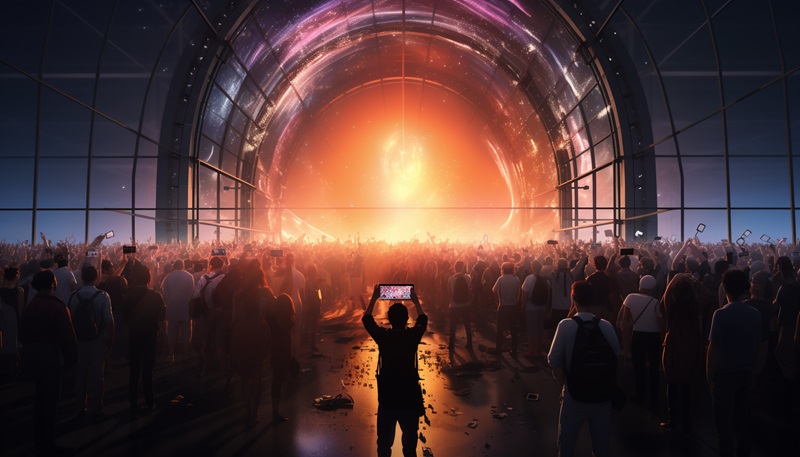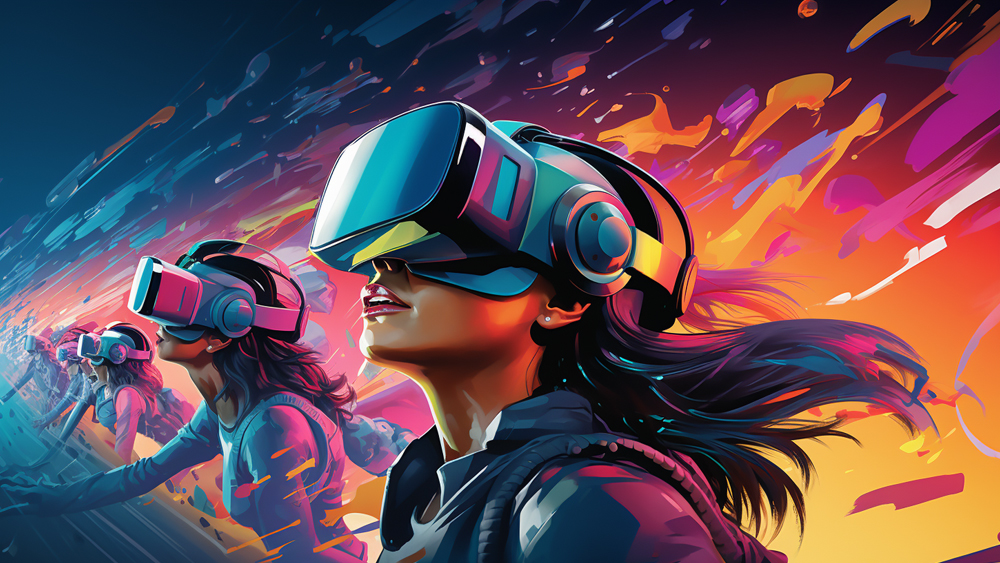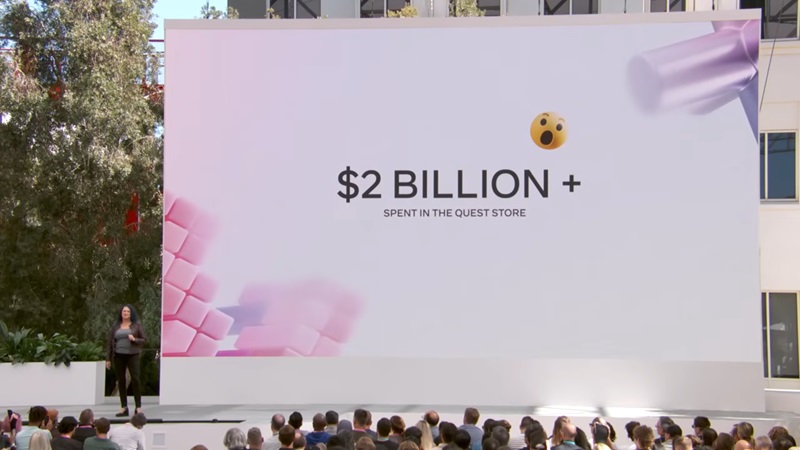In our last post, we delved into the exciting world of XR headsets, exploring the groundbreaking advancements that marked 2023 as a landmark year in augmented and virtual reality technology. From the versatile HTC VIVE XR Elite to the highly anticipated Apple Vision Pro, we highlighted how these devices are not only redefining the XR landscape but also setting the stage for a thrilling 2024. In this post, we turn our attention to other equally important parts of the XR machine - namely the rapid advancements in AI technology seen throughout 2023, along with other notable XR innovations and highlights.
The Rise of AI in 2023
While AI may have momentarily stolen the spotlight this year, the XR industry has in fact been eagerly anticipating these monumental breakthroughs in technology. 2023 has been a phenomenal year for AI progress, with tools like ChatGPT, DALL-E, and Midjourney (to name but a few) making headlines for their groundbreaking capabilities. However, it is important to note that AI innovations are not just standalone marvels; they are driving significant advancements across the augmented and virtual reality space, and hinting at what will likely turn into a symbiotic relationship between AI and spatial computing in the months and years to come.

The blend of AI and XR is opening up immersive experiences that were once only thought possible in the realms of science fiction. As both technologies continue to advance, their combination is poised to enhance user experiences across the board, making digital interactions and experiences more engaging, intuitive, and immersive.
In his welcome keynote at AWE EU in Vienna this October, AWE’s Ori Inbar highlighted how “XR is the interface for AI,” noting that it is actually XR technology that will give, or in some cases is already giving a face to AI. The two technologies are inextricably linked, and the advancements of 2023 have laid the groundwork for this partnership to blossom. Needless to say, 2024 is going to be an exciting year, and there is a reason that AI and XR are the two fastest growing sectors in tech.
Other Hardware from 2023 Driving the XR Revolution
Qualcomm Snapdragon XR2 Gen 2
Beyond the headsets and AI tools, the engine driving these XR experiences is the industry’s cutting-edge microchip technology. Qualcomm continues to be a driver of innovation in the XR space when it comes to microchip technology and 2023 saw the company once again demonstrate their industry leadership with the unveiling of the Qualcomm Snapdragon XR2 Gen 2 chipset.
The advanced platform set a new standard for VR and AR hardware with its 2.5 times greater GPU performance and 8 times enhanced AI capabilities compared to its predecessor the XR2 Gen 1. Notably, Gen 2 supports Wi-Fi 7 and offers 3K resolution per eye, which helps to significantly improve the visual fidelity of XR experiences.
Plus, thanks to the XR2 Gen 2's superior power efficiency and ability to handle advanced hardware features such as full-color passthrough, the chipset is not just a component; it's a catalyst, expanding the realm of possibility for more immersive and complex XR applications. There is no doubt that Qualcomm’s platform will continue to help pave the way for more immersive and complex applications throughout 2024.
Ray-Ban Stories
In the previous post we talked about XR HMDs, virtual reality and mixed reality headsets. But we left out augmented reality. While the AR market has yet to see as much traction, namely due to hardware constraints, some notable advances in the technology and consumer offerings were made. 2023 saw the launch of a new generation of Ray-Ban Stories, smart glasses from Meta and Ray-Ban that offered a stylish integration of AR in everyday life.
Designed to blend the iconic style of Ray-Ban with cutting-edge augmented reality technology, the new generation of Ray-Ban Stories come equipped with dual integrated 5MP cameras that allow users to capture photos and videos, and share their perspectives with the world. Plus, open-ear speakers and a three-microphone audio array allow for hands-free calls and voice control.
Although Ray-Ban Stories do not feature an AR HUD just yet, they still represent an important moment in AR, in that they represent the merging of technology with fashion and functionality. This is something that the industry has been waiting on for some time, and Ray-Ban Stories will hopefully act as a stepping stone towards newer designs of AR smart glasses that come in a stylish form factor, which is necessary for not only all-day use of wearable XR tech, but mainstream acceptance and adoption.
State of the XR Union and Monetary Milestones
As we reflect on the achievements of 2023, it's evident that the XR industry is not just growing; it's thriving. Another of Ori Inbar's keynotes (this time from AWE USA – shown below) perfectly captured the "State of the XR Union," which painted a picture of a vibrant, burgeoning industry. With a market value of $38 billion and a robust 30% annual growth since 2014, XR is a sector brimming with potential. Plus, today there are over a billion users who are now immersed in AR and VR experiences, which already indicates a mainstream acceptance and integration of these technologies in daily life.
To further this point, in 2023 Meta's Quest Store achieved a significant financial milestone, surpassing $2 billion in revenue from game and app sales. This announcement at the company’s Connect event earlier in the year only helped to reinforce the fact that there is a growing demand for VR content, and highlight XR’s growing presence within the wider technology market. Plus, Black Friday in 2023 saw the Quest 3 outsell Apple's AirPods and AirPods Pro headphones on Amazon – an incredible statistic given that the AirPods are accessory devices that can be used by pretty much anyone with a smartphone (so, almost 7 billion people). It seems consumer appetite for VR is certainly warming up.
These achievements are not just numbers; they represent the culmination of years of innovation and dedication. From the early days of AR browsers and the first consumer VR headsets to today's sophisticated hardware and software, the journey of XR has been one of constant evolution. And with each step, the industry is setting the stage for new applications across consumer and enterprise sectors, pushing the limits of technology and imagination.
2024: A Breakthrough Year for XR
The industry's evolution from its early days, including developments like the first AR browser and AR platform for the iPhone, or the first consumer VR headset that Oculus put out, has helped to pave the way for today’s XR landscape. This journey has of course been marked by significant hardware and software innovations, with varied applications across consumer and enterprise segments all contributing to the advancement of the technology.
The exciting thing is that this journey is still ongoing, hardware and software are still evolving, and 2023 has certainly been an instrumental year for putting all the pieces in place to take the XR story to the next level. It now feels like 2024 will likely be the year in which we witness this up-leveling of the industry.
Looking ahead, 2024 stands poised to be a breakthrough year for XR. The advancements in AI that we have witnessed to date have opened up exciting possibilities for the integration of artificial intelligence technology and tools within XR platforms. Plus, these new technological horizons that are now becoming visible have ignited a desire for more immersive and intuitive experiences, and XR is likely going to be at the heart of those.
The upcoming year also marks the 15th anniversary of AWE, symbolizing a significant milestone in the XR community. What’s more exciting is that you’ll be able to witness the growth of the AR/VR industry first hand at AWE’s events, and we’d love for you to be there and be a part of shaping the spatial computing industry with us.






